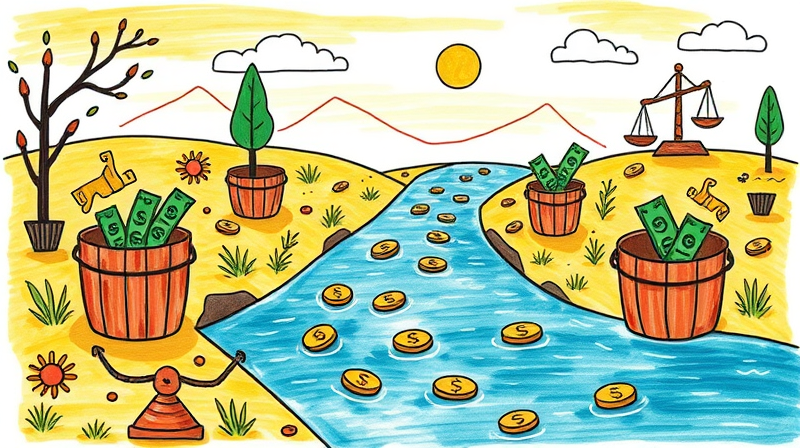
In today's unpredictable economic climate, the quest for financial stability encompasses more than just bank balances and investment returns. It touches on our emotional well-being, personal values, and long-term aspirations. This article explores how embracing a holistic approach to money management can transform stress into serenity and cultivate genuine peace of mind.
Financial literacy alone cannot shield us from unexpected life events, and ample savings do not guarantee emotional tranquility. True peace of mind emerges at the intersection of knowledge, preparation, and self-awareness. By weaving emotional insight into financial planning, we unlock lasting satisfaction that transcends momentary market fluctuations or headline-grabbing crises.
Financial wellness refers to the ability to comfortably manage personal finances and build habits that support both current needs and future goals. According to the Office of the Comptroller of the Currency, it means maintaining stable day to day finances, exhibiting resilience to withstand life’s shocks, and ensuring security for the future.
It is a multifaceted concept that integrates financial literacy, emotional comfort, lifestyle alignment, and progress toward meaningful objectives. This perspective moves beyond a static snapshot of net worth or income, emphasizing ongoing growth and adaptability.
We often measure success by our account statements, yet this misses the subjective dimension of money. Two people with identical net worth may experience vastly different levels of satisfaction and stress, depending on how closely their finances align with personal values and life goals. Financial wellness demands mindful reflection as well as practical skills.
Key aspects include financial literacy as the foundation for informed decisions, emotional comfort during uncertainties, and aligning goals so that money supports your life priorities.
The world in 2025 is grappling with heightened living costs, persistent inflation, and housing affordability challenges that intensify emotional and physical stress related to money. Sentiment surveys reveal that only 29% of individuals feel hopeful about their financial future—a sharp decline from 60% the previous year.
To illustrate the prevailing concerns:
Households worldwide are adapting: some are rationing essential expenses, others are delaying major purchases, and many are cautiously reallocating portfolios toward stable assets. While these measures offer short-term relief, they can also deprioritize saving for emergencies or retirement, creating a cycle of ongoing worry that undermines long-term wellness.
These statistics underscore a broader reality: financial stress manifests in fatigue, sleep disturbances, depression, and strained personal relationships. Recognizing these emotional and societal impacts highlights the necessity of moving beyond traditional financial metrics.
Conventional financial assessments focus on past balances and year-end reports, offering limited insight into a person’s values, aspirations, or emotional drivers. A narrow emphasis on figures can overlook the subjective forces that shape spending, saving, and investing behaviors.
In practice, this approach means defining personal values that guide spending, ensuring lifestyle compatibility with long-term objectives, recognizing emotional responses to money, and adopting active planning to align resources with desired outcomes.
Consider a young professional who meticulously tracks every expense yet feels perpetually anxious. Her detailed spreadsheets reveal consistent surpluses, but the pressure to meet societal benchmarks of success leaves her restless. By exploring her own motivations—whether to fund travel, support family, or achieve independence—she can reframe numbers into personal milestones that ignite passion rather than dread.
Financial wellness is underpinned by several interconnected pillars that create a resilient foundation:
Each pillar feeds into the next: literacy enables better habits, which in turn reinforce emotional security. As these elements strengthen, individuals can devote more energy to forward planning and the pursuit of meaningful experiences, rather than being preoccupied by budget shortfalls or market volatility.
Research indicates that individuals with strong financial literacy are 9% less likely to experience stress and anxiety linked to money concerns. They tend to enjoy better physical health, more satisfying relationships, and a forward-focused mindset that fuels personal growth.
For many, anxiety about money seeps into everyday life—resulting in poor sleep, strained families, and missed opportunities. Conversely, those who cultivate confidence in their financial strategies report increased creativity, stronger social bonds, and a heightened sense of purpose. Money becomes not a source of tension, but a tool for empowerment.
True abundance emerges when financial security supports both material and non-material aspirations. As 58% of younger adults now integrate money management into their overall wellness routines, the line between financial planning and self-care is becoming increasingly blurred.
Personalized support is revolutionizing how people engage with their finances. Digital tools and app-based platforms offer real-time insights and guidance, empowering users with tailored financial wellness programs that adapt to evolving needs. Employers are also expanding their benefits portfolios to include financial education, counseling services, and earned wage access options.
New technologies, such as AI-driven budgeting assistants and gamified saving platforms, are engaging users in fresh ways. These innovations offer interactive feedback, personalized alerts, and community challenges that make financial management both accessible and possibly even enjoyable. By merging behavioral science with intuitive design, these solutions reduce the friction that often blocks positive habits.
Low-cost, high-impact interventions—such as interactive budgeting apps, mental health resources, and on-demand coaching—are demonstrating measurable improvements in employee well-being, productivity, and retention. These innovations reflect a growing recognition that financial health is integral to overall wellness.
While systemic innovations provide valuable support, individuals can take proactive steps to fortify their financial foundation:
Remember, the goal is progress, not perfection. Each small victory—automating a savings transfer, paying off a credit card, or completing a financial literacy course—builds momentum that compounds over time. Celebrate these milestones and view setbacks as learning opportunities rather than failures.
Financial wellness is not a finite achievement but an evolving process rooted in self-awareness, adaptability, and intentional action. Begin by examining your emotional relationship with money and asking: What truly matters? How can my financial choices reflect my deepest values?
As you advance, revisit your plan regularly, adapting to new circumstances and insights. Financial wellness thrives on flexibility; rigid rules may falter under changing life demands. By staying curious and compassionate with yourself, you ensure that money remains a source of support rather than stress.
Remember that every step toward greater financial clarity nurtures both resilience and serenity. By weaving together practical planning, emotional well-being, and purposeful goals, you unlock a state of authentic abundance—one defined by the freedom to pursue your passions without the shadow of financial worry.
Embrace this holistic path, and allow your journey toward financial wellness to guide you beyond mere numbers to a place of enduring peace of mind.
References













